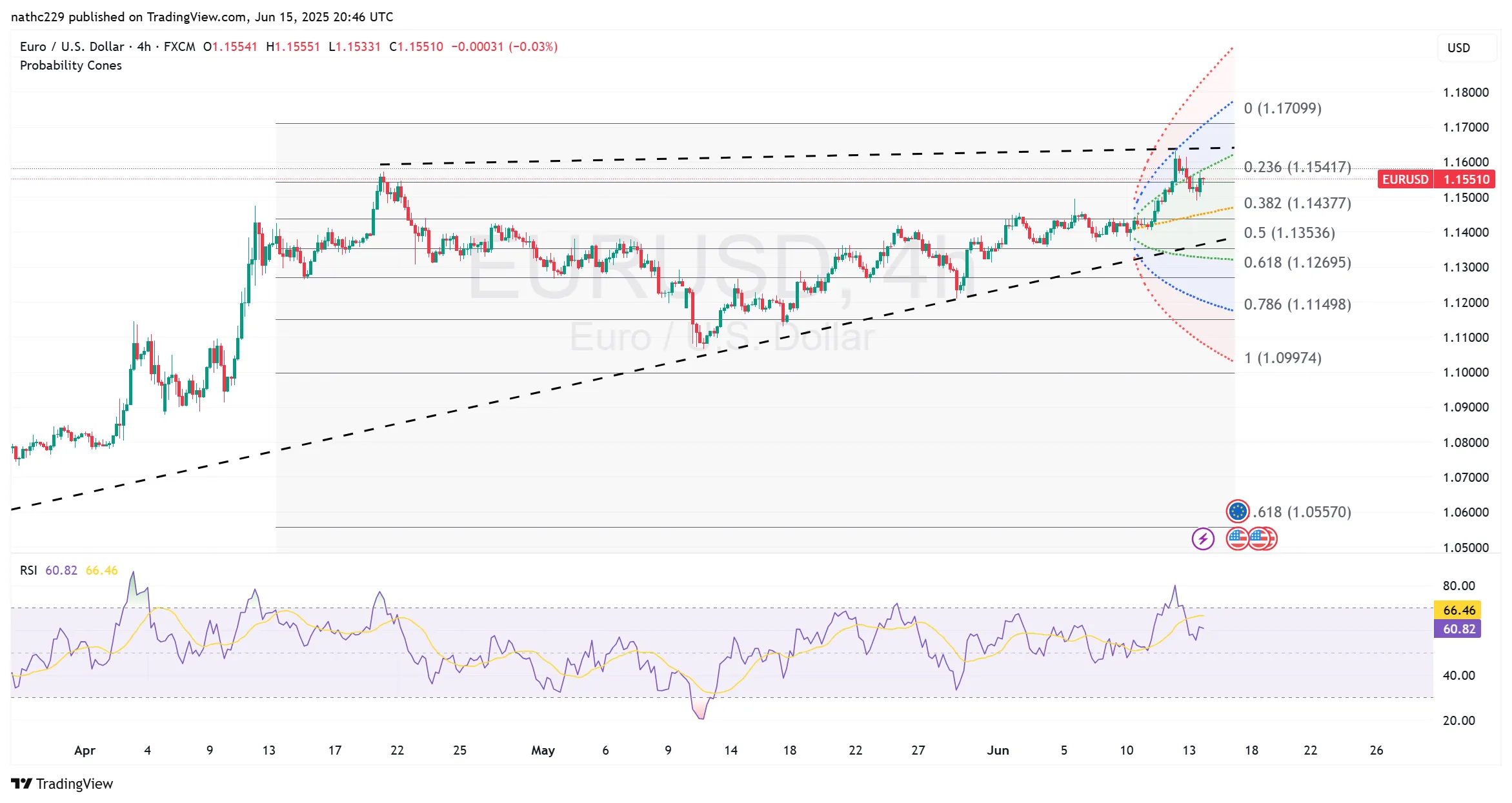
EUR/USD Bulls Defend Intraday Dip but Bearish Risks Persist
Overview
EUR/USD displayed resilience on Friday, recovering partially from overnight lows triggered by geopolitical tensions stemming from Israel’s strike on Iran. However, despite recovering intraday losses, bearish momentum ultimately prevailed on a weekly basis. Market participants face a complex interplay of technical bullish signals against growing fundamental and geopolitical risks.
Intraday Price Action and Geopolitical Catalysts
EUR/USD faced significant pressure overnight, dropping sharply to 1.1489 in response to Israel’s military actions against Iran, which initially boosted safe-haven demand for the U.S. dollar. New York’s session opening near 1.1505 marked the session’s turning point as risk appetite cautiously returned, easing the flight-to-safety flows and lifting EUR/USD to an intraday high at 1.1569.
The partial recovery was driven notably by a turnaround in global equities, a moderate retracement in gold’s gains, and EUR/JPY cross buying. Nonetheless, EUR/USD later retraced some of these intraday gains, sliding back towards the 1.1538 region, underscoring lingering cautious sentiment and uncertainty.
Technical Picture: Mixed Signals with Bullish Leanings
Technically, EUR/USD continues to send mixed signals. The pair closed down 0.41% on Friday but remains supported on a weekly basis, trading up approximately 1.20% for the week, indicating underlying buying interest.
The bullish technical stance is reinforced by the currency pair holding above both the 10-day and 21-day moving averages (DMAs). Additionally, the monthly RSI remains in a rising trajectory, suggesting positive medium-term momentum. The ability of EUR/USD to remain within Thursday’s trading range, despite the volatility triggered by geopolitical events, provides another subtle bullish technical indication.
However, these bullish signals are tempered by underlying caution, reflected in technical oscillators and options market positioning. EUR/USD is precariously positioned near significant resistance levels. Persistent failures to breach resistance convincingly could see a return to downside pressure, especially given heightened market caution.
Fundamental and Economic Indicators: Potential Drag on EUR/USD
U.S. economic indicators continue to pose significant challenges for EUR/USD longs. Despite signs of softening labor markets, the overall employment situation in the U.S. remains stable and resilient. Importantly, U.S. inflation indicators still show readings consistently above the Federal Reserve’s target range, complicating market expectations around monetary policy.
Recent data from the University of Michigan consumer sentiment survey showed marked improvement, suggesting continued consumer confidence and economic stability in the U.S. economy. If this resilience continues, it could sustain upward pressure on U.S. yields, thereby supporting the dollar against the euro.
Risks: Positioning and Geopolitical Uncertainty
Market positioning data from the Commodity Futures Trading Commission (CFTC) reveals a high concentration of net-long euro positions, currently near seven-month highs. Such significant long positioning poses an asymmetric risk; any pronounced shift in sentiment or technical breakdown could rapidly accelerate downside pressure as investors unwind bullish euro bets.
The options market further underscores growing caution among investors, reflected by declining volatility premiums for calls over puts in both 1-month and 3-month risk reversals since late May. This shift suggests heightened concern about EUR/USD’s prospects, indicating traders’ preference for hedging against potential declines.
Geopolitical risks remain a significant wildcard. The escalation of tensions in the Middle East between Israel and Iran introduces an additional layer of uncertainty. Continued or escalating hostilities could reinforce safe-haven dollar demand, placing downward pressure on EUR/USD.
Consequences and Strategic Recommendations
Given these complex dynamics, EUR/USD traders should maintain vigilance, closely monitoring upcoming economic data releases, particularly those related to inflation and employment in the U.S. Significant attention should also be paid to geopolitical developments, as sudden escalations could rapidly alter market sentiment.
Strategically, traders should consider short-term bullish positions cautiously, utilizing tight stop-loss orders near critical technical support levels around the 1.1489 to 1.1500 zone. Conversely, renewed bearish momentum could offer compelling short-selling opportunities if EUR/USD fails decisively at resistance around the 1.1560 to 1.1570 area.
Conclusion
In summary, EUR/USD’s near-term technical landscape displays cautious bullishness, tempered significantly by persistent economic strength in the U.S. and heightened geopolitical risks. Traders must balance these factors carefully, employing tight risk management given the market’s susceptibility to rapid sentiment shifts.
